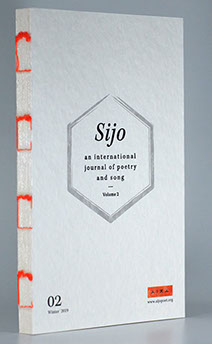Sijo an international journal of poetry and song accepts submissions of sijo in text, image, and multimedia formats here, or through the link below.
We review submissions once a year, toward the end of the summer. Anything that arrives before October 15 will be reviewed before the year’s last maple leaves fall on Soraksan. We don’t care if you have published or sent your sijo other places. But if you send us something, we’ll assume we can publish it without hurting anyone’s feelings or breaking any laws. Contributors appearing in the print journal will receive a complementary copy of the journal.
Find more information about our talented editorial board here: editorial board.
Sijo
an international journal of poetry and song
Sijo
an international journal of poetry and song
is devoted to publishing germinative poetry, art, and song that claims to participate in the sijo tradition. We are interested in both formally constrained work modeled on canonical texts, as well as writing which slants toward avant-garde modes and which uses the sijo form as a point of departure to venture toward experimental domains. We do not claim (nor desire, or indeed intend) to publish only ‘authentic sijo’ so much as publish texts that are uniquely authentic excursions into and across human experience and this ancient Korean form. Sijo—an international journal of poetry and song primarily publishes poems in English but accepts work in mixed script, multilingual, and multimedia formats.


Sijo
The sijo is a three-line Korean verse form. It might be viewed as a counterpart to the Japanese haiku, in the vernacular language vis-à-vis the Classical Chinese verse that defined formal occasions and ‘official’ cultural practices in Korea and Japan—as also in China—over the centuries.
The lines of the sijo are described as being in four parts-- phrases, segments, mutually comparable grammatical or rhythmic units. In the Korean-language sijo, the constituent units are usually three or four syllables in lines one and two. The third line, however, always begins with a three-syllable phrase, then moves to a longer phrase of five or more syllables, and then closes the poem down with four syllables and then three at the end.
Very often the sijo is formatted on the page with the lines split in two, since they can be long. The first line of the sijo introduces the subject and gets the poem moving; the second line is said to develop or continue the emotions or ideas of the first. The third line starts off with a change in thought, in focus, direction, voice or feeling. The three syllables at the beginning of the line underline this change of direction or focus. The poem is then brought to a conclusion over the balance of the third line as the line-units move from large, at five syllables in the second group, to smaller at four, to closure with three. Some descriptions compare this shape to the Classical Chinese quatrain, noting that the ‘turn’ in the third line of the Classical quatrain is accomplished in that ‘twist’ at the start of the sijo’s third, final line.
The vernacular, theatrical and gestural features of the sijo make it a most enticing form to explore in English as well as in other languages. Imagine, for example, a poem having each line a half-and-half mixture of Spanish and English, as two people talk or argue. Or let a poem move like Psy dancing and prancing in his K-Pop hit, “Kangnam Style.” Others can be quieter, contemplative, though still aware of the space around, and of the people and objects occupying it.
Here is a regular sijo in the English language. The lines are roughly four units each, though with a range in syllable count from 5-3 in the first half line, to a whopping 4-11-7-8 in line three. The syllable count, it might be suggested, doesn’t need to be adhered to in English.
Lost & Found
Jumped down, turned around, she wasn’t there!
First day new stop, old stop, wrong!
Took off running after the bus down Brattle,
across Willard Street, three blocks down Mt. Auburn,
and there she was! peering up into the bus door opening
as he ran up calling out “Here I am, Mommy! Here I am!”
This next poem is more open in form and considerably more spare in syllables, but to me it still feels like a sijo: three lines broken up on the page, yet with that twist in the action-verb call.
Calligraphic
equip us
each one with a brush
and see the forms
our language takes
open the room
take down the walls
that shape our spirits
hear the lines
call as they spill
see them
topple from the page
See for yourselves what the sijo can do! Enjoy, be moved, and then write!

Sijo
submissions

Sijo
an international journal of poetry and song
12 Hayward Ave., Lexington, Massachusetts, 02421
